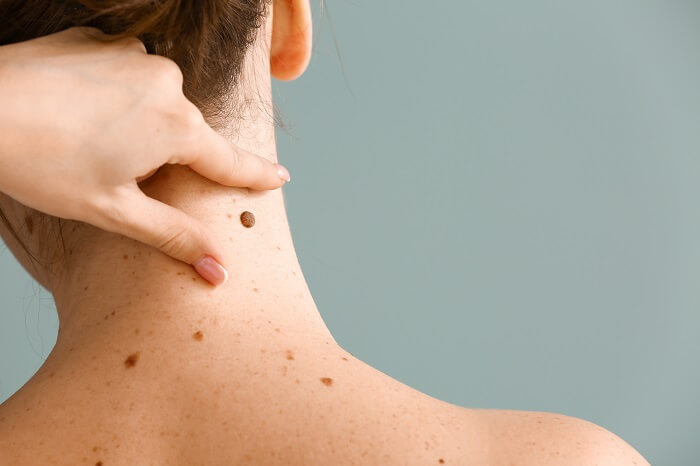Moles (the medical name is nevus – the plural is nevi) are common, often benign spots on the skin. The vast majority of people have at least one mole, and it’s not unusual for these skin spots to develop in childhood and early adulthood. However, moles, especially those that develop later in life, can also be early warning signs of melanoma skin cancer, so it’s important to pay attention to your moles and have them checked by a professional. Many patients ask if it’s normal to get a new mole. We tell them that while most new moles are harmless, it’s always important to bring a new spot to your dermatologist’s attention, as every knew mole should be properly evaluated. Old existing moles should also be monitored as best as possible for changes; any growth or change in appearance is a reason to call your dermatologist. Keep reading to learn more about what concerns may be related to the development of new moles and how to respond if you’re worried about the development of a new mole.
What are the Types of Moles?
The different types of moles aren’t actually unique skin lesions. Instead, all moles are areas where there is a higher concentration of melanocyte skin cells. These are the cells that give our skin its coloring. So, it’s no surprise that moles, made up entirely of pigment-producing melanocytes, are typically darker than the natural skin tone. Mole types are categorization tools used to help your dermatologist determine the risk for skin health concerns.
To determine whether or not a mole is something to worry about, you should first identify what type of mole you’re dealing with. The following are the most common:
- Congenital moles – The word nevus actually means birthmark, and birthmarks or congenital moles are one the most common form of moles. They appear during birth or shortly after. The majority of birthmarks will clear up or lighten naturally over time, and those that don’t may be removed for cosmetic or preventive purposes. Specifically, large congenital moles are more likely to develop cancer later in life, so your dermatologist may recommend having these birthmarks removed.
- Common moles – These may also be called acquired moles, and they appear on the skin in childhood or as you age. They can develop on any part of the body. Common moles are much more likely to develop in people with lighter skin tones. After they appear, common moles are typically unchanging, relatively small, and remain a consistent color. People who have numerous common moles are at greater risk for skin cancer, and they should visit the dermatologist for professional exams each year as well as performing self-checks at home.
- Atypical moles – These types of moles are also called dysplastic nevi. They can develop on any part of the body, but they are much more likely to form on the torso, back, chest, head, neck, or scalp. This benign type of mole is most likely to be mistaken for skin cancer since they look very similar. Often called the “ugly duckling” of moles, atypical moles have irregular border shapes, vary in color and texture, grow very large, and may be asymmetrical. These are all characteristics common in cancerous lesions, so it’s important to have atypical moles checked by your dermatologist. Additionally, having four or more atypical moles puts you at a significantly higher risk for melanoma. Because atypical moles are difficult to differentiate from melanoma, your dermatologist will likely recommend removal.
- Spitz nevus – This is a rare type of mole that is benign, but like atypical moles, spitz nevi can look a lot like melanoma lesions. This type of mole usually develops before the age of 20. A spitz nevus will typically have a round, symmetrical shape, which differentiates them from cancerous lesions. However, they are fast-growing and may have variations in pigmentation that are very similar to melanoma. Because it’s difficult to differentiate a spitz nevus from cancerous lesions, a dermatologist will likely recommend removal.
What Causes New Moles to Appear?
New moles are relatively common in childhood, but it’s much rarer for adults to develop new moles after the age of 30. It’s not completely clear to researchers and medical professionals what causes new moles to appear later in life. However, some common risk factors seem to play a role in causing new mole development, including:
- Sunlight – Exposure to the sun’s ultraviolet rays is often at fault for the development of new skin spots and moles.
- Family history – People who have family members with moles are more likely to develop them later in life. An inherited mutation of the BRAF gene is the cause of many moles that develop in adults. Other genetic traits that predispose individuals to develop moles include light skin tones and red hair.
- Age – As we get older, our skin tone can become less even, leading to darker spots on the skin.
- Medications – Immune system suppressing drugs, hormones, and antidepressants may all increase the risk for new mole development.
What are the Warning Signs that a Mole is Something to Worry About?
While moles that develop later in life aren’t necessarily something you need to be extremely worried about, they can be a warning sign of skin cancer, so it’s important to monitor any changes or growth and let your dermatologist know about your new mole as soon as possible. When it comes to determining whether or not a mole is something to be concerned about, it’s important to know the most common warning signs of skin cancer.
You may have heard your dermatologist talk about these warning signs as the ABCDEs of skin cancer, which are:
- A – Asymmetry – A mole is not even on both sides.
- B – Border – The mole’s border is not smooth or solid.
- C – Color – The mole’s color is different from other moles on the body or varies within the mole itself.
- D – Diameter – The mole is larger in diameter than a pencil eraser.
- E – Evolving – The mole is changing or growing.
While these warning signs are the most common indicators that a mole is cancerous, a few other symptoms to check for during regular skin exams include:
- A painful mole
- Bleeding or seeping moles
- Moles that form sores or ulcers
Visit U.S. Dermatology Partners for an Annual Skin Exam
We encourage patients to check their skin every month and keep a complete record of their moles and other spots and lesions. Whenever changes or new spots develop, you should contact your dermatologist for a professional exam. Even if you don’t notice any changes or new moles, you should schedule an appointment at U.S. Dermatology Partners at least once each year for a professional exam. If it’s time for your annual skin exam or you’ve noticed a new mole that worries you, request an appointment with a dermatologist on our team by completing our simple online scheduling form.
Find a location near me
or



